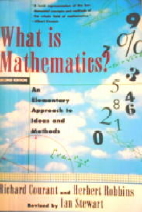 Can the presence of intelligent behavior in other creatures (creatures that don’t have a nervous system comparable to ours) tell us something about what ideas are, or how thought fits into nature’s actions? It has always seemed to us humans that our ideas are one of the fruits of what we call our ‘intelligence.’ And the evolutionary history of this intelligence is frequently traced back through the archeological records of our first use of things like tools, ornamentation, or planning. It is often thought that our intelligence is just some twist of nature, something that just happened. But once set in motion, it strengthened our survival prospects, and gave us an odd kind of control of our comfort and well-being. We tend to believe that ‘thoughts’ are a private human experience, not easily lined up with nature’s actions. Thoughts build human cultures, and one of the high points of thought is, of course, mathematics. Remember, it was the scarecrow’s reciting the Pythagorean Theorem that told us he had a brain. Even though he got it wrong.
Can the presence of intelligent behavior in other creatures (creatures that don’t have a nervous system comparable to ours) tell us something about what ideas are, or how thought fits into nature’s actions? It has always seemed to us humans that our ideas are one of the fruits of what we call our ‘intelligence.’ And the evolutionary history of this intelligence is frequently traced back through the archeological records of our first use of things like tools, ornamentation, or planning. It is often thought that our intelligence is just some twist of nature, something that just happened. But once set in motion, it strengthened our survival prospects, and gave us an odd kind of control of our comfort and well-being. We tend to believe that ‘thoughts’ are a private human experience, not easily lined up with nature’s actions. Thoughts build human cultures, and one of the high points of thought is, of course, mathematics. Remember, it was the scarecrow’s reciting the Pythagorean Theorem that told us he had a brain. Even though he got it wrong.
When an animal is able to learn something and apply that learning to a new circumstance we generally concede that this is also intelligent behavior. A good deal of research has been done on animals like chimpanzees, dolphins, and apes, where the ability to learn symbolic representations or sophisticated communication skills mark intelligent behavior. But these observations don’t significantly change our sense that intelligence is some quirk of the brain, and only in humans has this quirk gone through the development that gives birth to ideas and culture, and puts us in our unique evolutionary place.
But when intelligent behavior is observed in a bumble bee, for example, we have to think a little more. The bumble bee’s evolution isn’t particularly related to our own, and their brains are not like ours. More than one million interconnected neurons occupy less than one cubic millimeter of brain tissue in the bee. The density of neurons is about ten times greater than in a mammalian cerebral cortex. Research published in Nature (in 2001) is described in a Scientific American piece in 2008 by Christof Koch.
The abstract of the Nature paper includes this:
…honeybees can interpolate visual information, exhibit associative recall, categorize visual information, and learn contextual information. Here we show that honeybees can form ‘sameness’ and ‘difference’ concepts. They learn to solve ‘delayed matching-to-sample’ tasks, in which they are required to respond to a matching stimulus, and ‘delayed non-matching-to-sample’ tasks, in which they are required to respond to a different stimulus; they can also transfer the learned rules to new stimuli of the same or a different sensory modality. Thus, not only can bees learn specific objects and their physical parameters, but they can also master abstract inter-relationships, such as sameness and difference.
And Koch makes this observation:
Given all of this ability, why does almost everybody instinctively reject the idea that bees or other insects might be conscious? The trouble is that bees are so different from us and our ilk that our insights fail us.
In 2015, Koch coauthored a paper with Giulio Tononi, the focus of which was consciousness. There he argues:
Indeed, as long as one starts from the brain and asks how it could possibly give rise to experience—in effect trying to ‘distill’ mind out of matter, the problem may be not only hard, but almost impossible to solve. But things may be less hard if one takes the opposite approach: start from consciousness itself, by identifying its essential properties, and then ask what kinds of physical mechanisms could possibly account for them. (emphasis added)
Potential clues to different kinds of physical mechanisms are described in a very recent Scientific American article that reports on the successful unraveling of the octopus genome.
Among the biggest surprises contained within the genome—eliciting exclamation point–ridden e-mails from cephalopod researchers—is that octopuses possess a large group of familiar genes that are involved in developing a complex neural network and have been found to be enriched in other animals, such as mammals, with substantial processing power. Known as protocadherin genes, they “were previously thought to be expanded only in vertebrates,” says Clifton Ragsdale, an associate professor of neurobiology at the University of Chicago and a co-author of the new paper. Such genes join the list of independently evolved features we share with octopuses—including camera-type eyes (with a lens, iris and retina), closed circulatory systems and large brains.
Having followed such a vastly different evolutionary path to intelligence, however, the octopus nervous system is an especially rich subject for study. “For neurobiologists, it’s intriguing to understand how a completely distinct group has developed big, complex brains,” says Joshua Rosenthal of the University of Puerto Rico’s Institute of Neurobiology. “Now with this paper, we can better understand the molecular underpinnings.”
In 2012, Scientific American reported on the signing of the Cambridge Declaration on Consciousness.
The weight of evidence indicates that humans are not unique in possessing the neurological substrates that generate consciousness,” the scientists wrote. “Non-human animals, including all mammals and birds, and many other creatures, including octopuses, also possess these neurological substrates.
And from the Declaration:
Furthermore, neural circuits supporting behavioral/electrophysiological states of attentiveness, sleep and decision-making appear to have arisen in evolution as early as the invertebrate radiation, being evident in insects and cephalopod mollusks (e.g., octopus).
Specific mention of the octopus was based on the collection of research that documented their intentional action, their use of tools, and their sophisticated spatial navigation and memory. Christof Koch was one of the presenters of the declaration and was quoted as saying, “The challenge that remains is to understand how the whispering of nerve cells, interconnected by thousands of gossamer threads (their axons), give rise to any one conscious sensation.”
My friend and former agent, Ann Downer, has a new book due out in September with the provocative title, Smart and Spineless: Exploring Invertebrate Intelligence. It was written for young adults and is a wonderful way to correct an old perspective for growing thinkers.
These many insights suggest that what we call intelligence is not something that happens to some living things, but is, perhaps, somehow intrinsic to life and manifest in many forms. Koch suggests that we begin a study of consciousness by identifying its essential properties and mathematics can likely help with this. It does so already with Giulio Tononi’s Integrated Information Theory of Consciousness. But mathematics is a grand scale investigation of pure thought – of the abstract relationships that are often related to language, learning, and spatial navigation (to name just a few). As a fully abstract investigation of such things, it could help direct the search for the essential properties of awareness and cognition. And the chance that we will find the ubiquitous presence of such properties in the world around us may breath new life into how we understand nature itself.


[…] Thinking without a brain […]